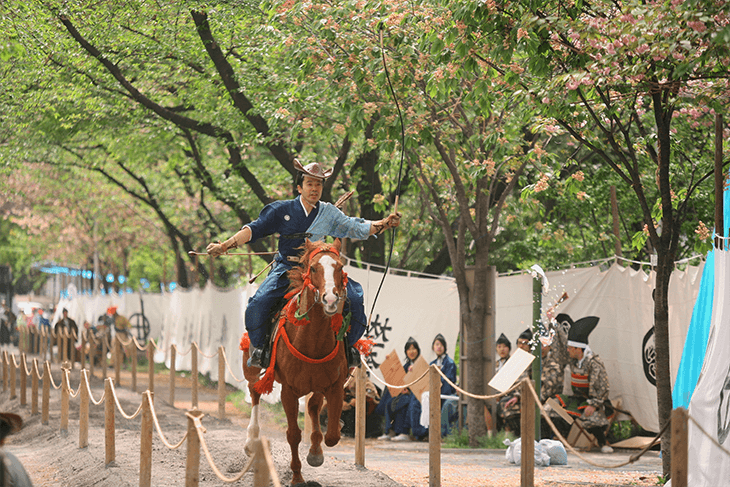
As the stallion thunders down the track, the rider yells a guttural cry, cocks a long feathered shaft, takes aim and lets fly at a target on a bamboo pole. Bam! The wooden square splits in three, releasing a cloud of confetti that flutters down toward the sand. By the time it nears the ground, the rider is already aiming at the next target down the track.
-
Traditional festivals are celebrated throughout Japan but few are as thrilling as yabusame: archers in traditional samurai hunting attire firing off arrows from the backs of galloping horses. Asakusa, Tokyo’s spiritual heart and home to Sensojii temple, has welcomed back its annual yabusame festival after a four-year hiatus during the coronavirus pandemic, so saddle up and read on to learn everything you need to know about this celebration of martial prowess.
-
02
A proud tradition
While equestrian archery in Japan dates back to at least the late 7th century, the Asakusa Yabusame festival has its origins in the Edo period (1603–1867), when it was performed at Asakusa Shrine as part of New Year observances. Shoguns patronized the art from the 18th century through the fall of the Tokugawa shogunate. Established some 850 years ago under the Kamakura shogunate, the Ogasawara-ryu school of archery and etiquette preserved the art over the centuries, holding yabusame ceremonies at Kamakura’s Tsuruoka Hachiman Shrine. It began organizing yabusame along Tokyo’s Sumida River after World War II. Now led by Kiyotada Ogasawara, the 31st-generation master, the Ogasawara-ryu school includes archers young and old, male and female, and from Japan and overseas. They learn not only archery but how to move to observe the traditional forms of etiquette.
![Image courtesy of Taito City]()
Image courtesy of Taito City
“The posture that a samurai adopts as his ideal is efficient, rational, and also beautiful. To learn it, core and lower body strength are indispensable,” Kiyotada has said . “Those who have just started to practice basic movements such as walking, standing, and sitting may be totally exhausted and not be able to get up the next morning due to muscle pain. In fact, it is said that it takes ten years to learn how to walk according to etiquette.”
Today, the Asakusa Yabusame festival is held each May at Sumida Park between the river and Asakusa Shrine, located beside Sensoji Temple. There are two parts to the festival: kusajishi, or the Grass Deer Archery Ceremony, and yabusame. The former traces its roots to 1194, when a hunting party under Shogun Minamoto no Yoritomo (1147–1199) was pursuing deer near Mt. Fuji but archers kept missing their targets. Yoritomo had a warrior fashion a deer-shaped target out of grasses and his men used it for practice. This tradition continues today when standing archers arrayed in Heian era (794–1185) costume take aim at a mockup deer in an archery ground toward the northern end of Sumida Park.![Photo by Tim Hornyak]()
Photo by Tim Hornyak
-
03
Trackside thrills
The equestrian archery is the main event at the Asakusa Yabusame, and unlike the kusajishi archery, it is ticketed, so attendees should reserve a spot well in advance. The yabusame tournament is marked by pageantry, ritual, color and drama. It begins with a prayer and ceremonial purification, followed by a parade of archers, judges, officials and attendants attired in costumes from the Heian, Kamakura (1185–1333) or Edo periods. They include taikokata, who beat taiko drums to signal different stages of the tournament, ogikata, who signal with hand fans when horses begin their run, matometsuke, who are target judges, and heifuri, who raise hei staffs tipped with streamers. After a series of explanations in Japanese and English by the emcee, the tournament begins.
As their mounts gallop down the 255-meter-long track, the archers yell, “In-yo-i!” Meaning light and darkness, this is a reference to yabusame’s onmyodo cosmology influenced by the ancient Chinese concept of ying and yang. While paying tribute to this philosophical tradition, the archers have only a few seconds to hit three wooden targets along the track to their left. The wooden squares represent the unprotected faces of samurai warriors in full armor.
After years of training on mokuba wooden horses, the archers have great strength and the proper posture, which calls for the bowstring to be drawn back with the arrow at about eye level. They’re also proficient at controlling real horses with their knees, leaving their hands free to manipulate the bow and arrow.![Image courtesy of Taito City]()
Image courtesy of Taito City
If an archer fails to take an arrow from the quiver and nock it to the bowstring quickly enough to fire at a target, he or she must let it drop to the ground. When a target is hit, the nearest heifuri raises the hei and its white paper streamers. Archers who manage to hit all three targets will receive a white silk sash from the tournament judges, considered a great honor and a mark of divine fortune.
Lasting about three hours, the Asakusa Yabusame festival is held against the backdrop of Tokyo Skytree, the world’s tallest tower, and presents a brilliant mix of old and new in Japan. You don’t have to be a fan of Japanese history or martial arts to thoroughly enjoy this remarkable tradition that has been handed down for nearly a thousand years.
The Asakusa Yabusame festival takes place every May at Sumida Park.
For details and ticket information you can contact or visit the Asakusa Culture Tourist Information Center, located opposite Sensoji Temple.




 Go here
Go here





